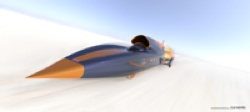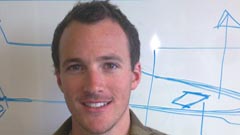A magazine where the digital world meets the real world.
On the web
- Home
- Browse by date
- Browse by topic
- Enter the maze
- Follow our blog
- Follow us on Twitter
- Resources for teachers
- Subscribe
In print
What is cs4fn?
- About us
- Contact us
- Partners
- Privacy and cookies
- Copyright and contributions
- Links to other fun sites
- Complete our questionnaire, give us feedback
Search:
Faster than a speeding bullet

A flat, parched section of desert will, in a few years’ time, become a stage. The drama played out on it in October 2011 will star the screaming rockets and air-gulping jet engine of the world’s fastest car, Bloodhound SSC. The driver, Andy Green, will be attempting to blaze his way into a new land speed record at 1000 miles per hour. That’s about five times faster than the fastest road car in the world. It’s also about twice the speed of an airliner, one and a half times the speed of sound and even faster than the bullet from a .357 Magnum. There’s no getting over it – when Andy Green is strapped behind the wheel of Bloodhound SSC he will be going very, very fast indeed.
The Bloodhound gang
Bloodhound’s designers haven’t got to the desert yet. Right now, in fact, they’re in Wales. Their team make sure Bloodhound works the way Andy wants it to. He’ll be the only person ever to drive it, so they’re building it to steer and respond the way he likes. But even more importantly, the designers are the ones responsible for Bloodhound’s sleek body shape – like a fighter plane with wheels. In the old days the airflow over a car’s body got lots of testing inside wind tunnels, but wind tunnels can’t reproduce the extreme conditions Bloodhound will face. Instead the aerodynamics will all be designed and tested with computer simulations.
Ben Evans, an engineer at Swansea, works on those simulations, and he explains that there were two main things to think about when designing Bloodhound. You want the car to stay on the ground, and you want it to flow smoothly through the air – the lower the drag, the faster the car can accelerate. Any car needs to have good aerodynamics, but it’s going to be incredibly important for Bloodhound because of the speed they expect it to reach. The right shape won’t just make it faster, it’ll mean the difference between piloting a car and an out-of-control fireball.
Use the forces

An ordinary car can depend on the Earth’s gravity and the traction of the wheels to help keep it steady, but when you’re going so fast you can outrun a bullet those helpful forces are too weak to rely on. ‘To make it a land speed record car it has to be steered using wheels, not aerodynamic devices,’ says Ben. ‘But actually, above about 300, 400 miles an hour, the aerodynamic forces acting on the wheels…those forces are far larger than the actual traction forces between the wheel and the desert surface.’ So the wheels on Bloodhound will really work more like fins on an airplane.
The aerodynamics at 1000 mph don’t just affect the steering. Since the aerodynamic forces are ten times larger than gravity at that speed, the designers need to make sure the shape of the car helps push it into the ground. Except they need to test that shape in their models to make sure they get it right. Ben explains that ‘if you push down too hard on the car you can easily turn it into a plow, or an aircraft – and we don’t want it to be either of those things.’
So what will happen when the team from Swansea go to the desert? They’ll start sending the car off on trial runs to see if it’s behaving the way they expect it to from their simulations. They’ll start off slowly, says Ben. ‘We’re obviously not going to tell Andy Green, the driver, to go out to the desert and put his foot down, off you go, a thousand miles an hour.’ Sensors all over the car will report back to the designers whether their predictions were correct. This testing phase takes a while – about three years – but they need to make sure everything’s right before Andy fires up the afterburners for the record attempt.
Green-coloured car
What’s the impact on the Earth of this rocket-powered adventure? The team know that it might not seem too green to be shooting across a desert in a jet on wheels, but Bloodhound will have a surprisingly small carbon output – for the few years it’s running, this jet-powered speed demon will produce about as much carbon as five normal cars. That’s not nothing of course, and so there are other ways that Bloodhound is helping to offset its impact on the Earth. You learn a lot about efficiency from designing the world’s fastest car entirely on computers, so the lessons from making Bloodhound leaner and meaner will help others to design airplanes and cars that use less fuel.
The need for speed
You might think that one of the designers of a 1000-mph car has always been a huge petrolhead. ‘Yeah, it’s a funny thing,’ says Ben, ‘When this project landed on my desk and I was asked if I was interested, I didn’t know the first thing about cars – I mean I drive around in a little Fiat Panda 1.1 litre and I’ve never been involved in car racing or anything like that.’ He says it’s the scientific challenge of Bloodhound that gets him really excited. When that scientific challenge is exploding through the sound barrier in a thousand-mph missile on wheels, we think it sounds pretty exciting too.


